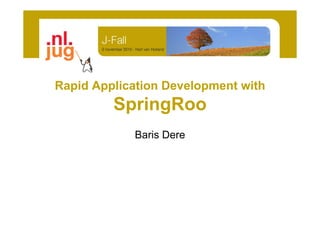Rapid application development with spring roo j-fall 2010 - baris dere
- 1. Rapid Application Development withRapid Application Development with SpringRoop g Baris Dere
- 2. Agenda ? SpringRoo introduction ? Why use it? ? Beginning with SpringRooBeginning with SpringRoo ? SpringRoo architecture Add? Add-ons ? Usage and conventions ? Roadmap and resources
- 3. About Me ? Senior Software Engineer / Technical Lead ? 11 years experience with Java ? SCJP SCJD SCWCD SCBCDSCJP, SCJD, SCWCD, SCBCD, SCEA(in progress) ? MCP MCAD NET? MCP, MCAD.NET ? RUP Certified ? Author for Java Magazine in Turkey
- 4. SpringRoo introduction (1) ? Open source (Spring subproject) ? Released in December 2009 (version 1.0) ? Ben Alex ¨C LeadBen Alex Lead ? Java 5 JDK or higher A h M 2 0 9 hi h? Apache Maven 2.0.9 or higher ? Latest stable version 1.1.0 (October 2010)
- 5. SpringRoo introduction (2) ? Extensible, text based RAD tool ? Command-line shell or STS ? Active/Passive code generationActive/Passive code generation ? Maintaining files during project lifecycle N t ti (d l t ti l )? Not a runtime (development-time only) ? Not an IDE plugin
- 6. DEMODEMO
- 7. Why use it? ? Higher Java productivity ? Stock-Standard Java ? Usable and LearnableUsable and Learnable ? Easy to remove N E i i T d Off? No Engineering Trade-Offs
- 8. Why use it? (2) ? Higher Java productivity ¨C Takes days to start a new project ¨C Reuse their existing knowledge, skills and experience
- 9. Why use it? (3) ? Stock-Standard Java ¨C Existing Java knowledge ¨C Commonly used technologies ¨C SpringSource-certified best-practice application architecture
- 10. Why use it? (4) ? Usable and Learnable ¨C Text-based interfaces are often more appropriate than GUIs ¨C Tab-based completion system ¨C Contextual awareness ¨C Command abbreviation ¨C ¡°hint¡± command
- 11. Why use it? (5) ? Easy to remove ¨C Risks to use a tool ¨C SpringRoo does not exist at runtime ¨C Easy to remove SpringRoo ? Push in refactor ? Regular expression based find and replace
- 12. Why use it? (6) ? No Engineering Trade-Offs ¨C Incremental dependency addition approach ¨C AspectJ's excellent compile-time weaving approach ? no dynamic proxy creation overhead
- 13. Beginning with SpringRoo ? Installation ? Starting a typical project ¨C Persistent layer / Reverse Engineeringy g g ¨C Web layer ¨C Integration and Selenium testsIntegration and Selenium tests ¨C Securing the application ¨C IDE supportIDE support ¨C Customizing ¨C BackupBackup
- 14. DEMODEMO
- 15. SpringRoo architecture ? Command-line shell ? Core components ? AspectJ ITD¡¯s for ¡°active¡± generationAspectJ ITD s for active generation ? Optional Services Layer N DAO L? No DAO Layer ? Add-ons
- 17. SpringRoo architecture (3) ? Command-line shell ¨C Perform a ¡°startup¡± scan ¨C Monitor file system ¨C Handle explicit directives from the user
- 18. SpringRoo architecture (4) ? Core components
- 19. SpringRoo architecture (5) AspectJ ITD¡¯s for ¡°active¡± generation
- 20. SpringRoo architecture (6) ? Optional Services Layer ¨C Most logic can be placed in the web controller ? Exceptions:p ¨C Need multiple entities ¨C Business logic callable from outside (remote, timer,Business logic callable from outside (remote, timer, etc) ¨C Easier to test (mock http requests)( p q ) ? Create Services Layer ¨C Annotate your service class with @ServicesAnnotate your service class with @Services
- 21. SpringRoo architecture (7) ? No DAO Layer ¨C Not strictly essential to creating typical web applications ¨C Request ROO-301 - Vote
- 22. Add-ons ? Adobe Flex ? Apache ActiveMQ ? Java Bean Validation ? Java Database Connectivity ? SpringSource Tool Suite ? Spring Integration ? Apache Maven ? Apache OpenJPA ? Apache Tiles y ? Java Message Service ? Java Persistence API ? Java Transaction API g g ? Spring Framework ? Spring Security ? Spring Web Flow ? Apache Tomcat ? AspectJ ? AspectJ Development Tools ? Cloud computing ? Java Server Pages ? Jetty ? JUnit ? Log4J ? URL Rewrite Filter ? Web application resource (WAR) packaging ? Cloud computing ? Dojo Toolkit ? Eclipse IDE ? EclipseLink ? Log4J ? Representational State Transfer (REST) ? Selenium ? Google Web Toolkit ? Google App Engine ? Hibernate J 5 ? OSGi add-ons ? Solr search ? SpringSource tc Server with Insight? Java 5+ Insight
- 23. Add-ons (2) addon create simple --topLevelPackage com.mycompany.myproject.roo.addon ? Create a CommandMarker implementation Annotate with @ScopeDevelopmentShell p p g y p y yp j ? Annotate with @ScopeDevelopmentShell ? Create a command method ? Annotate with @CliCommand(value=¡°¡±, title=¡°¡±) ? Create a command available method ? Annotate with @CliAvailabilityIndicator(¡°¡±)? Annotate with @CliAvailabilityIndicator( ) ? Perform package
- 24. Add-ons (3) ? Version 1.1.0 (27th of October 2010) ? Apache Felix ¨C OSGi Framework ? Service Component Runtime for componentService Component Runtime for component management ? OSGi Bundle Repository for bundle resolution? OSGi Bundle Repository for bundle resolution ? Out-of-the-box hosting on Google Code ? PGP based security infrastructure ? Email OBR repository URL to s2-p y roobot@vmware.com
- 25. Add-ons addon create simple --topLevelPackage com mycompany myproject roo addonaddon create simple topLevelPackage com.mycompany.myproject.roo.addon
- 26. Usage and conventions ? File conventions ¨C Roo will never change a .java in your project unless you explicitly ask it ¨C Only .jspx and *_Roo_*.aj updated ¨C Never change the *_Roo_*.aj files ? IDE Usage ¨C Use AJDT pluginp g ? Shell features ¨C Save your Roo commandsSave your Roo commands ¨C Hinting, tab completion
- 27. Roadmap and resources ? More Add-ons ¨C Comet & Bayeux ¨C Ajax (partial page refresh) ¨C Ordering & sorting of entities ? Documentation ? Project resources
- 28. Project resources ? Project home: ¨C http://www.springsource.org/roo ? Forum: ¨C http://forum.springsource.org/roo ? Issues:Issues: ¨C https://jira.springframework.org/browse/ROO ? Twitter:? Twitter: ¨C @SpringRoo





























